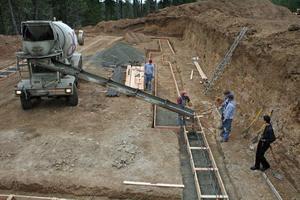In many cases, a do-it-yourself blind area is arranged to drain surface water, which is designed to extend the life of the foundation and the structure as a whole. It, as a rule, is a waterproof strip adjacent to the base of the building with a slight slope. The design itself largely depends on the layout option and geological conditions. Before starting work, it is necessary to consider the organization of the gutter from the roof and financial capabilities. The simplest blind area of the foundation for individual construction consists of a fifteen-centimeter layer of crumpled clay and a hard coating in the form of gravel or other similar materials. The lower layer acts as a waterproofing, providing, in turn, the removal of surface water.

When the blind area is done with your own hands, its width must be correctly selected. Ideally, it should go beyond the eaves overhang by twenty centimeters. Storm grooves are made on all sides to provide drainage. However, instead of them, special gutters are allowed, which are most appropriate when the lawn is located nearby. In addition, the water that has got into them will drain into a
storm well. Most often, work to create a surface water drain is carried out simultaneously with the foundation, but sometimes it is better to wait a year after the construction of the house.
The most capital blind area, which can be made today, is a monolithic concrete slab around the building, with a thickness of 60 to 80 mm. However, this option is not suitable for
heaving soils. Most individual developers do not take this feature into account, therefore, they often repair the coating, and monolithic slabs continue to crack. The main reason is that the soil is saturated with water extremely unevenly.
A monolithic concrete blind area, built with your own hands, is considered the best option, but it has one more significant minus. Due to the fact that it is quite difficult to achieve the desired mixture density, many pores can be seen on the surface. During operation, water penetrates such microcracks all the time. When freezing, it expands, causing the destruction of concrete. First, the surface peels off, and then it peels off altogether. After some period, the upper layer is completely destroyed. This phenomenon is very common in everyday life.
In order not to encounter such problems, the correct blind area is made of separate plates, which can be made independently. For their production at home, special formwork will be required, and it is better to build two such structures. The beads should be cut into each other, pressing from the outside with wedges so that after completion of work the formwork can be quickly disassembled. Products for the blind area must be reinforced, because even a small frame will increase the strength characteristics, which will save on cement and sand. The option with plates is more suitable where there is an unorganized drain from the roof.